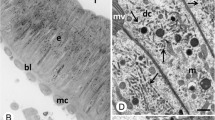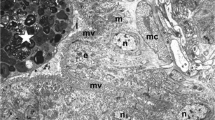Abstract
The blastogenic cycle of the colonial ascidian Botryllus schlosseri concludes in a phase of selective cell and zooid death called takeover. Every week, all asexually derived parental zooids synchronously regress over a 30-h period and are replaced by a new generation. Here we document the sequential ultrastructural changes which accompany cell death during zooid degeneration. The principal mode of visceral cell death during takeover occurred by apoptosis, the majority of cells condensing and fragmenting into multiple membrane-bounded apoptotic bodies. Cytoplasmic organelles (mitochondria, basal bodies, striated rootlets) within apoptotic bodies retained ultrastructural integrity. Dying cells and fragments were then swiftly ingested by specialized blood macrophages or intraepithelial phagocytes and subsequently underwent secondary necrotic lysis. Certain organs (stomach, intestine) displayed a combination of necrotic and apoptotic changes. Lastly, the stomach, which demonstrated some of the earliest regressive changes, exhibited intense cytoplasmic immunostaining with a monoclonal antibody to ubiquitin at the onset of takeover. Affinity-purified rabbit antiserum against sodium dodecyl sulfate-denatured ubiquitin detected a characteristic 8.6-kDa mono-ubiquitin band by Western blot analysis. Collectively, these findings raise the possibility that cell death during takeover is a dynamic process which requires active participation of cells in their own destruction.
Similar content being viewed by others
References
Arends MJ, Morris RG, Wyllie AH (1990) Apoptosis: the role of the endonuclease. Am J Pathol 126:593–608
Beaulaton J, Lockshin RA (1977) Ultrastructural study of the normal degeneration of the intersegmental muscles of Antheraea polyphemus and Manduca sexta (Insecta, Lepidoptera) with particular reference to cellular autophagy. J Morphol 154:39–58
Berrill NJ (1942) The developmental cycle of Botrylloides. Quart J Microscop Sci 88:393–407
Boyd HC, Brown SK, Harp JA, Weissman IL (1986) Growth and sexual maturation of laboratory-cultured Monterey Botryllus schlosseri. Biol Bull Woods Hole Mass 170:91–109
Burighel P, Schiavinato A (1984) Degenerative regression of the digestive tract in the colonial ascidian (Botryllus schlosseri Pallas). Cell Tissue Res 235:309–318
Chau V, Tobias JW, Bechmaire A, Marriott D, Ecker DJ, Gonda DK, Varshavsky A (1989) A multiubiquitin chain is confined to specific lysine in a targeted short-lived protein. Science 243:1576–1583
Cohen JJ (1991) Programmed cell death in the immune system. Adv Immunol 50:55–85
Duke RC, Chervenak R, Cohen JJ (1983) Endogenous endonuclease-induced DNA fragmentation: an early event in cell-mediated cytolysis. Proc Natl Acad Sci USA 80:6361–6365
Duvall E, Wyllie AH (1986) Death and the cell. Immunol Today 7:115–119
Ellis HM, Horvitz HR (1986) Genetic control of programmed cell death in the nematode C. elegans. Cell 44:817–829
Ellis LC, Youson JH (1990) Pronephric regression during larval life in the sea lamprey Petromyzon marinus L. A histochemical and ultrastructural study. Anat Embryol 182:41–52
Ellis RE, Yuan J, Horwitz HR (1991) Mechanisms and functions of cell death. Annu Rev Cell Biol 7:663–698
Finley D, Chau V (1991) Ubiquitination. Annu Rev Cell Biol 7:25–69
Finley D, Bartel B, Varshavsky A (1989) The tails of ubiquitin precursors are ribosomal proteins whose fusion to ubiquitin facilitates ribosome biogenesis. Nature 338:394–401
Haas AL, Bright PM (1985) The immunochemical detection and quantitation of intracellular ubiquitin-protein conjugates. J Biol Chem 260:12464–12473
Harp JA, Tsuchida CB, Weissman IL, Scofield VL (1988) Autoreactive blood cells and programmed cell death in growth and development in protochordates. J Exp Zool 247:257–262
Hayes MP, Berreki GA, Henkart PA (1989) Induction of target cell DNA release by the cytotoxic T lymphocyte granule protease granzyme A. J Exp Med 179:933–946
Hedgecock EM, Sulston JE, Thomson JN (1983) Mutations affecting programmed cell death in the nematode Caenorhabditis elegans. Science 220:1277–1279
Hershko A (1988) Ubiquitin-mediated protein degradation. J Biol Chem 263:15237–15240
Hinchcliffe JR, Ede DA (1973) Cell death in the development of limb form and skeletal pattern in normal and wingless (Ws) chick embryos. J Embryol Exp Morphol 30:753–772
Hurle J, Hinchcliffe JR (1978) Cell death in the posterior necrotic zone (PNZ) of the chick wing-bud: a stereoscan and ultrastructural survey of autolysis and cell fragmentation. J Embryol Exp Morphol 43:123–136
Kerr JFR, Wyllie AH, Currie AR (1972) Apoptosis: a basic biological phenomenon with wide-ranging implications in tissue kinetics. Br J Cancer 26:239–257
Kerr JFR, Harmon B, Searle J (1974) An electron-microscope study of cell deletion in the anuran tadpole tail during spontaneous metamorphosis with special reference to apoptosis of striated muscle fibers. J Cell Sci 14:571–585
Kinoshita T, Takahama H, Sasaki F (1991) Changes in the function of dermal fibroblasts in the tadpole tail during anural metamorphosis. J Exp Zool 257:166–177
Laemmli UK (1970) Cleavage of structural protein during the assembly of the head of bacteriophage T4. Nature 227:680–685
Lauzon RJ, Ishizuka KJ, Weissman IL (1992) A cyclical developmentally-regulated death phenomenon in a colonial wrochordate. Dev Dyn 194:71–83
Murphy KM, Heinberger AB, Loh DY (1990) Induction by antigen of intrathymic apoptosis of CD4+CD8+TCRLO thymocytes in vivo. Science 250:1720–1723
Murti KG, Smith HT, Fried VA (1988) Ubiquitin is a component of the microtubule network. Proc Natl Acad Sci USA 85:3019–3023
Rinkevich B, Lauzon RJ, Brown BWM, Weissman IL (1992) Evidence for a programmed lifespan in a colonial protochordate. Proc Natl Acad Sci USA 89:3546–3550
Robertson AMG, Thompson JN (1982) Morphology of programmed cell death in the ventral nerve cord of Caenorhabditis elegans larvae. J Embryol Exp Morphol 67:89–100
Saunders JW Jr (1966) Death in embryonic systems. Science 154:604–612
Savill JS, Wyllie AH, Henson JE, Walport MJ, Henson PM, Haslett C (1989) Macrophage phagocytosis of aging neutrophils in inflammation. Programmed cell death in the neutrophil leads to recognition by macrophages. J Clin Invest 83:865–875
Savill JS, Dransfield I, Hogg N, Haslett C (1990) Vitronectin receptor-mediated phagocytosis of cells undergoing apoptosis. Nature 343:170–173
Schiaffino S, Burighel P, Nunzi MG (1974) Involution of the caudal musculature during metamorphosis in the ascidian, Botryllus schlosseri. Cell Tissue Res 153:293–305
Schwartz LM, Kosz L, Kay BK (1990a) Gene activation is required for developmentally programmed cell death. Proc Natl Acad Sci USA 87:6594–6598
Schwartz LM, Jyer A, Kosz L, Engelstein M, Maier C (1990b) Activation of polyubiquitin gene expression during developmentally programmed cell death. Neuron 5:411–419
Shi P, Szoley MG, Paskar L, Boyer M, Singh R, Green DR (1990) Activation-induced cell death in T cell hybridomas is due to apoptosis. Morphologic aspects and DNA fragmentation. J Immunol 144:3326–3333
Smith CA, Williams GT, Kingston R, Jenkinson EJ, Owen JJT (1989) Antibodies to CD3/T-cell receptor complex induce death by apoptosis in immature T cells in thymic cultures. Nature 337:181–184
Smith PK, Krohn RI, Hermanson GT, Mallia AK, Gartner FH, Provenzano MD, Fujimoto ER, Goeke NM, Olson DJ, Klink DC (1985) Measurement of protein using bicinchoninic acid. Anal Biochem 150:76–85
Tian G, Streuli M, Saito H, Schlossman SF, Anderson P (1991) A polyadenylate binding protein localized to the granules of cytolytic lymphocytes induces DNA fragmentation in target cells. Cell 67:629–639
Ucker DS (1987) Cytotoxic T lymphocytes and glucocorticoids activate an endogenous suicide process in target cells. Nature 327:62–64
Watanabe H (1953) Studies on the regulation in fused colonies in Botryllus primigenus (Ascidiae Compositae). Sci Rep Tokyo Bunrika Daigaku 7:183–198
Watanabe H (1962) Further studies on the regulation in fused colonies in Botryllus primigenus (Ascidiae Compositae). Sci Rep Tokyo Kyoik Daigaku 10:253–284
Weissman IL, Saito Y, Rinkevich B (1990) Allorecognition histocompatibility in a protochordate species: is the relationship to MHC semantic or structural? Immunol Rev 113:227–241
Wyllie AH (1980) Glucocorticoid-induced thymocyte apoptosis is associated with endogenous endonuclease activation. Nature 284:555–556
Wyllie AH, Morris RG (1982) Hormone-induced cell death. Purification and properties of thymocytes undergoing apoptosis after glucocorticoid treatment. Am J Pathol 109:78–87
Wyllie AH, Kerr JFR, Currie AR (1980) Cell death: the significance of apoptosis. Int Rev Cytol 68:251–305
Yamada T, Ohyama H (1988) Radiation-induced interphase death of rat thymocytes is internally programmed (apoptosis). Int J Radiat Biol 53:65–75
Zychlinsky A, Zheng LM, Liu CC, Young JDE (1991) Cytolytic lymphocytes induce both apoptosis and necrosis in target cells. J Immunol 148:393–400
Author information
Authors and Affiliations
Rights and permissions
About this article
Cite this article
Lauzon, R.J., Patton, C.W. & Weissman, I.L. A morphological and immunohistochemical study of programmed cell death in Botryllus schlosseri (Tunicata, Ascidiacea). Cell Tissue Res 272, 115–127 (1993). https://doi.org/10.1007/BF00323577
Received:
Accepted:
Issue Date:
DOI: https://doi.org/10.1007/BF00323577




